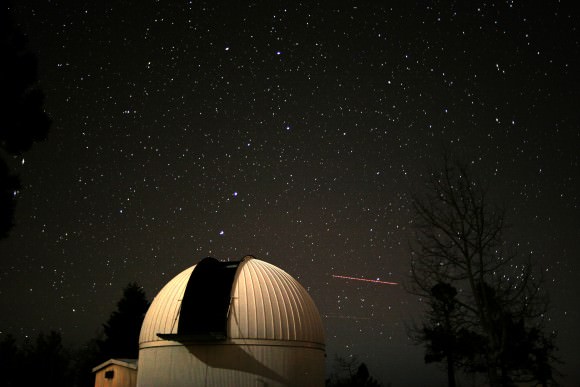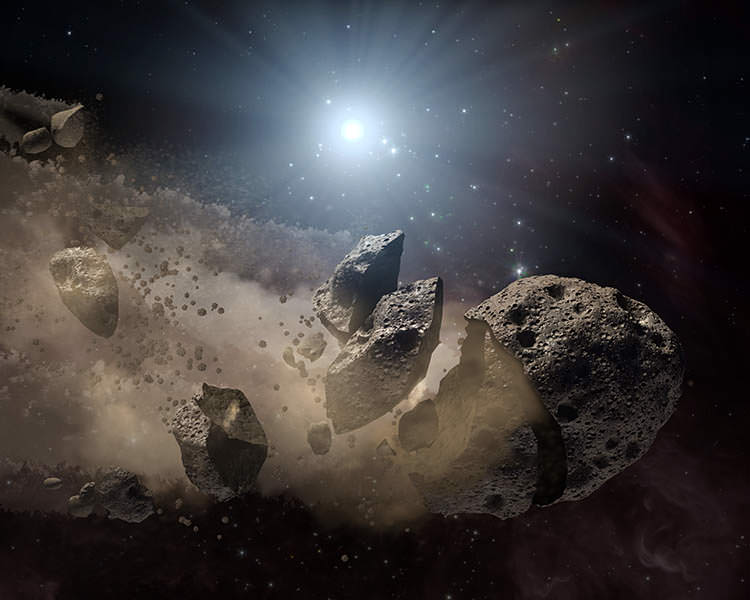The Sun has enormous destructive power. Any objects that collide with the Sun, such as comets and asteroids, are immediately destroyed.
But now we’re finding that the Sun has the ability to reach out and touch asteroids at a far greater distance than previously thought. The proof of this came when a team at the University of Hawaii Institute of Astronomy was looking at Near-Earth Objects (NEOs) catalogued by the Catalina Sky Survey, and trying to understand what asteroids might be missing from that survey.
An asteroid is classified as an NEO when, at its closest point to the Sun, it is less than 1.3 times the distance from the Earth to the Sun. We need to know where these objects are, how many of them there are, and how big they are. They’re a potential threat to spacecraft, and to Earth itself.

The Catalina Sky Survey (CSS) detected over 9,000 NEOs in eight years. But asteroids are notoriously difficult to detect. They are tiny points of light, and they’re moving. The team knew that there was no way the CSS could have detected all NEOs, so Dr. Robert Jedicke, a team member from the University of Hawaii Institute of Astronomy, developed software that would tell them what CSS had missed in its survey of NEOs.
This took an enormous amount of work—and computing power—and when it was completed, they noticed a discrepancy: according to their work, there should be over ten times as many objects within ten solar diameters of the Sun as they found. The team had a puzzle on their hands.
The team spent a year verifying their work before concluding that the problem did not lay in their analysis, but in our understanding of how the Solar System works. University of Helsinki scientist Mikael Granvik, lead author of the Nature article that reported these results, hypothesized that their model of the NEO population would better suit their results if asteroids were destroyed at a much greater distance from the sun than previously thought.
They tested this idea, and found that it agreed with their model and with the observed population of NEOs, once asteroids that spent too much time within 10 solar diameters of the Sun were eliminated. “The discovery that asteroids must be breaking up when they approach too close to the Sun was surprising and that’s why we spent so much time verifying our calculations,” commented Dr. Jedicke.
There are other discrepancies in our Solar System between what is observed and what is predicted when it comes to the distribution of small objects. Meteors are small pieces of dust that come from asteroids, and when they enter our atmosphere they burn up and make star-gazing all the more eventful. Meteors exist in streams that come from their parent objects. The problems is, most of the time the streams can’t be matched with their parent object. This study shows that the parent objects must have been destroyed when they got too close to the Sun, leaving behind a stream of meteors, but no apparent source.
There was another surprise in store for the team. Darker asteroids are destroyed at a greater distance from the Sun than lighter ones are. This explains an earlier discovery, which showed that brighter NEOs travel closer to the Sun than darker ones do. If darker asteroids are destroyed at a greater distance from the Sun than their lighter counterparts, then the two must have differing compositions and internal structure.
“Perhaps the most intriguing outcome of this study is that it is now possible to test models of asteroid interiors simply by keeping track of their orbits and sizes. This is truly remarkable and was completely unexpected when we first started constructing the new NEO model,” says Granvik.


Was there any sense of what was the destructive quality? Heat? Magnetic disturbances (though I’d guess that would only work on metal asteroids,) solar wind devolving orbits causing orbital decay?
if that is true why have i seen a LOT of them comets passing too close to our Sun and emerging from behind in one piece escaping alife ?
But the sun couldn’t possibly effect our climate. Only man can do that.
But the sun couldn’t possibly effect our climate. Only man can do that.
UT, I just registered and this is my first comment yet, your site is telling me it is a duplicate comment. Wut up, son?
UT, I just now registered and this is my very first comment yet, your site is telling me it is a duplicate comment. Wut up wit dat, son?
Wow, three comments just to spread silly climate science denialist propaganda.